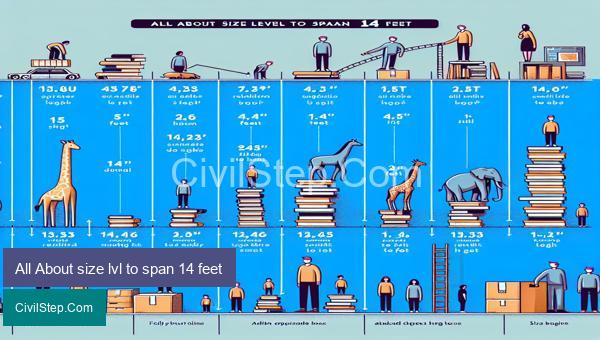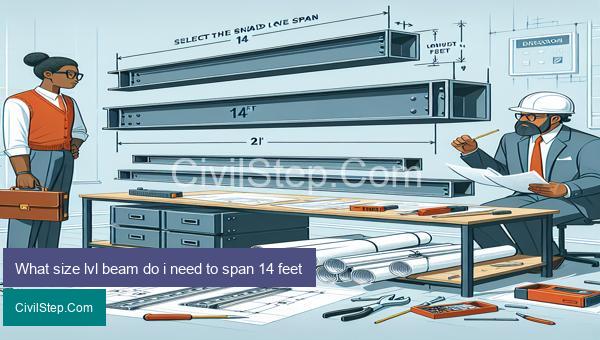
Building structures with extensive spans requires consideration for the appropriate size lvl to support the weight and maintain structural integrity. Size lvl refers to laminated veneer lumber, a type of engineered wood product that offers a combination of durability, strength, and versatility. In this article, we will discuss everything you need to know about size lvl specifically for spanning 14 feet, including its advantages and applications in construction projects. Whether you are a homeowner looking to build a new deck or a professional builder constructing a commercial building, understanding the key aspects of size lvl is crucial for a safe and successful project.
What size lvl to span 14 feet

The size of the Laminated Veneer Lumber (LVL) beam required to span 14 feet will depend on various factors such as the type of load it will be supporting, the spacing of the supports, and the species and grade of the LVL. LVL beams are commonly used in construction to provide structural support for floors, roofs, and walls.
In general, as the span increases, the size and strength of the LVL beam also need to increase. This is because longer spans require the beam to withstand larger forces and moments, which can cause deflection and potential failure if not properly designed.
According to the American Wood Council’s Residential Structural Design Guide, a single-span LVL beam with a span of 14 feet can support a live load of 40 pounds per square foot (psf) and a dead load of 10 psf, with a maximum deflection of L/360 (L being the span length). This means the LVL beam should not deflect more than 0.39 inches (10 mm) under the maximum load.
Using this guide, a roof with a 14-foot span would require a minimum LVL size of 2-1/2 inches x 9-1/2 inches or larger, depending on the loading conditions. Alternatively, for a floor with the same span, a minimum LVL size of 1-3/4 inches x 9-1/2 inches or larger would be needed. However, it is recommended to consult a structural engineer or use structural design software for more accurate beam sizing.
Other factors that can affect the size of the LVL beam include the spacing of the supports. A wider spacing will require a larger beam size as it would have to support a larger area. The species of the LVL also plays a significant role as different species have different mechanical properties and can support different loads. The grade of the LVL is also crucial, as higher grades can support larger loads and have smaller deflections.
In conclusion, the size of the LVL beam required to span 14 feet will depend on the type of load, spacing of the supports, species, and grade of the LVL. It is essential to follow local building codes and regulations and consult a structural engineer for accurate sizing to ensure the safety and stability of the structure.
What size lvl beam do i need to span 14 feet

To determine the appropriate size LVL (laminated veneer lumber) beam for a 14-foot span, several factors must be considered such as the load that the beam will support, the spacing of the supporting posts, and the grade of the LVL beam. LVL beams are often used in construction for their strength, consistency, and resistance to warping or shrinking.
Firstly, the load that the beam will bear is an important factor in determining its size. A beam that will support a roof will have a different load than a beam that will support a floor. This load is usually measured in pounds per square foot (PSF) and can vary depending on the type of structure and its intended use. For example, a residential floor typically has a PSF of 40-50 while a roof can range from 30-55 PSF.
Secondly, the spacing of the supporting posts will also impact the size of the LVL beam needed. The closer the posts are, the smaller the beam can be. For a 14-foot span, the standard post spacing is typically 8 feet apart, although this can also vary depending on the specific project.
Finally, the grade of the LVL beam is also an important consideration. LVL beams come in different grades, denoted by a number such as 1.5E or 1.9E. This number represents the modulus of elasticity, which indicates the strength and stiffness of the beam. The higher the number, the stronger and stiffer the beam will be.
Based on these factors, for a 14-foot span with a standard post spacing of 8 feet and a typical residential floor load of 40-50 PSF, a 3.5” x 11.875” 1.9E LVL beam would be suitable. However, it is always best to consult with a structural engineer or building code guidelines to ensure the appropriate size beam is chosen for the specific project.
In conclusion, the size of the LVL beam needed to span 14 feet will depend on the load, post spacing, and grade of the beam. By considering these factors, a suitable and safe LVL beam can be chosen to support the structure and meet all necessary building codes.
What size lvl beam for a 14 foot span

When it comes to determining the appropriate size for a laminated veneer lumber (LVL) beam for a 14 foot span, there are several factors that need to be considered. These include the load that the beam will support, the species of the lumber, and the spacing between supports.
First, it is important to understand what an LVL beam is. LVL, also known as microlam or glulam, is a type of structural beam made by layering thin strips of wood together and bonding them with adhesives. This creates a strong and durable beam that is able to support heavy loads.
The amount of load that the LVL beam will need to support is a crucial factor in determining its size. The most common type of load is known as a uniform load, which is a constant weight bearing down on the beam from above. In general, for a residential application, a 14 foot span LVL beam should be able to support a total load of around 5,000 to 6,000 pounds.
The species of the lumber used is also an important consideration. Common species used for LVL beams include Douglas fir, Southern pine, and spruce. These species have different strength characteristics, so it is important to consult a span table or a structural engineer to determine the appropriate size for the specific species being used.
In addition to the species, the spacing between supports also affects the size of the LVL beam needed. The more supports there are, the less weight each support will need to bear and the smaller the beam can be. For a 14 foot span, the typical spacing between supports is 16 inches on center.
Based on these factors, a 14 foot span LVL beam typically ranges in size from 3.5 inches by 9.25 inches to 5.25 inches by 11.875 inches. However, it is always best to consult a structural engineer to determine the appropriate size based on the specific application and load requirements.
In conclusion, the size of the LVL beam needed for a 14 foot span will depend on the load it will support, the species of lumber, and the spacing between supports. Careful consideration and proper calculations are important to ensure the safety and stability of any structure using LVL beams.
What size lvl to span 14 feet

The size of the Laminated Veneer Lumber (LVL) beam required to span 14 feet will depend on various factors such as the type of load it will be supporting, the spacing of the supports, and the species and grade of the LVL. LVL beams are commonly used in construction to provide structural support for floors, roofs, and walls.
In general, as the span increases, the size and strength of the LVL beam also need to increase. This is because longer spans require the beam to withstand larger forces and moments, which can cause deflection and potential failure if not properly designed.
According to the American Wood Council’s Residential Structural Design Guide, a single-span LVL beam with a span of 14 feet can support a live load of 40 pounds per square foot (psf) and a dead load of 10 psf, with a maximum deflection of L/360 (L being the span length). This means the LVL beam should not deflect more than 0.39 inches (10 mm) under the maximum load.
Using this guide, a roof with a 14-foot span would require a minimum LVL size of 2-1/2 inches x 9-1/2 inches or larger, depending on the loading conditions. Alternatively, for a floor with the same span, a minimum LVL size of 1-3/4 inches x 9-1/2 inches or larger would be needed. However, it is recommended to consult a structural engineer or use structural design software for more accurate beam sizing.
Other factors that can affect the size of the LVL beam include the spacing of the supports. A wider spacing will require a larger beam size as it would have to support a larger area. The species of the LVL also plays a significant role as different species have different mechanical properties and can support different loads. The grade of the LVL is also crucial, as higher grades can support larger loads and have smaller deflections.
In conclusion, the size of the LVL beam required to span 14 feet will depend on the type of load, spacing of the supports, species, and grade of the LVL. It is essential to follow local building codes and regulations and consult a structural engineer for accurate sizing to ensure the safety and stability of the structure.
Conclusion
In conclusion, size lvl spanning 14 feet is a popular choice for construction projects due to its strength and versatility. Its use in beams, joists, and rafters offers stability and support for various structures. Understanding the different grade levels, sizes, and limitations of size lvl can help in selecting the right option for a specific project. With proper installation and maintenance, size lvl can provide long-lasting and reliable results. It is clear that size lvl is a key component in modern construction, and its many benefits make it a top choice for builders and contractors.
